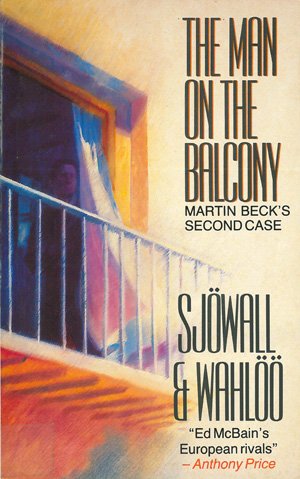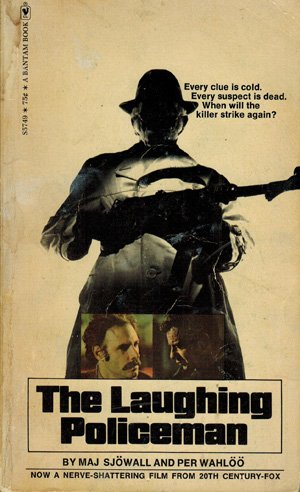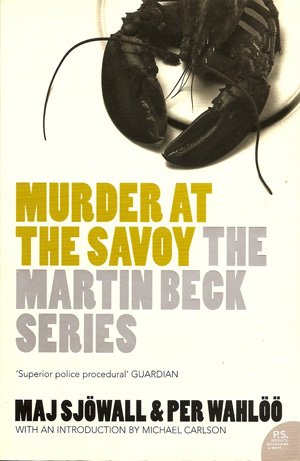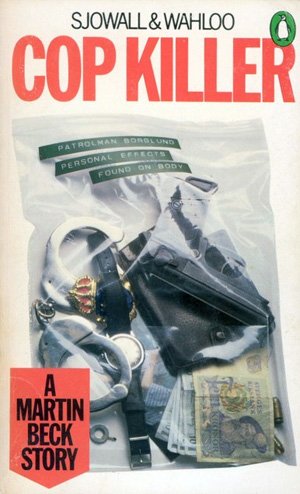 Between 1965 and 75, the husband and wife team of Maj Sjöwall and Per Wahlöö (above) wrote a series of 10 police procedurals set in Stockholm, all carrying the subtitle ‘The Story of a Crime’. Their work was distinct from other crime fiction at the time due to the attention given to the personal lives of the detectives, an emphasis on forensic procedure and, most importantly, how each case held a magnifying glass over society at large. The series features the dyspeptic Detective Martin Beck and his Murder Squad, working cases in the Swedish capital. The homicides they investigate carry them through all strata of society, where skeletons are found in every closet. For Beck and his team, closing a case also means navigating the insufferable bureaucracy of the police, sometimes against all odds.
Between 1965 and 75, the husband and wife team of Maj Sjöwall and Per Wahlöö (above) wrote a series of 10 police procedurals set in Stockholm, all carrying the subtitle ‘The Story of a Crime’. Their work was distinct from other crime fiction at the time due to the attention given to the personal lives of the detectives, an emphasis on forensic procedure and, most importantly, how each case held a magnifying glass over society at large. The series features the dyspeptic Detective Martin Beck and his Murder Squad, working cases in the Swedish capital. The homicides they investigate carry them through all strata of society, where skeletons are found in every closet. For Beck and his team, closing a case also means navigating the insufferable bureaucracy of the police, sometimes against all odds.
The birth of a sub-genre
The Martin Beck novels gave rise to the Nordic noir sub-genre. They are the classics and nearly all crime fiction originating in Scandinavia has been influenced – directly, or indirectly – by Maj Sjöwall and Per Wahlöö’s work. One of the books formed the basis for the 70s film The Laughing Policeman, even though it was set in San Francisco, and several others were filmed in German and Swedish. There have been radio adaptations and between 1997 and 2018, there have been seven Swedish TV series with Peter Haber as Martin Beck, and written by the likes of Rolf and Cilla Börjlind.
Scandinavian crime fiction is famous for its use of the gloomy climate to mirror the detective’s tortured psyche. But here each murder victim also speaks volumes about the socio-political climate that is intimately woven into the narrative of police work. Martin Beck’s fictional cases are an historical prism charting Sweden’s progress building its famous welfare state and social democracy. The authors were journalists too, and wanted to explore the moral grey areas of society where so much was meant to be good, but where institutional corruption, the soulless machinations of the police state, terrorism, and the alienation of the citizenry also festered. Their Marxist leanings were no secret, but the novels never feel didactic, and their wry humour always makes us chuckle. Beck himself loathes politics and takes no outward stance. He always supports his colleagues, however incompetent, even as new policies threaten to undermine his ability to do his job.
A thriving market
Sjöwall and Wahlöö used an interesting technique. They would write alternate chapters individually, blending the realism and inherent tedium of police procedure with an irreverent commentary. Their brand of murder, bad weather and social commentary continues to be very much in demand, as is evident in the success of Henning Mankell, Stieg Larsson, Jo Nesbø, Karin Fossum, Arnaldur Indriðason, and many others. Just as their influence endures across crime fiction’s continental borders, so do many of their themes. The trenchant issues in these early novels are prescient of today’s headlines, where increasing social inequality and the militarisation of the police remain vital fodder for crime fiction.
And while all that sounds quite serious, let’s not forget that the Martin Beck series is very entertaining. The stories provide a virtual tour of the Swedish countryside with its variety of dialects and character types. The personal and professional travails of Beck, Kollberg and their colleagues in the Murder Squad become so familiar you can’t help but follow them with genuine concern.
The collaboration between the authors, who were in a 13-year relationship, ended prematurely when Per Wahlöö died after an operation necessitated by pancreatic cancer in 1975. They are so highly regarded in Swedish that stamp was made in their honour in 2010. What follows is a guide to the series – perfect if you want to discover the classics of Scandinavian crime fiction…
Roseanna (1965)
 The series begins with the nude body of a young woman found by a dredger in Lake Vättern, in the small district of Motala. It turns out to be an American librarian named Roseanna McGraw who was raped and murdered. When we are introduced to Martin Beck and his investigative team, they all appear quite cranky and don’t even get involved in the case until well into the book. Beck, a chronic smoker, has a perpetual cold and upset stomach, symptoms which seem to align with his failing marriage. He is aided by Sten Lennart Kollberg, an overweight, free-thinking sensualist who detests guns. Kollberg’s appearance belies his martial arts ability. He can be lithe as a tiger when needed.
The series begins with the nude body of a young woman found by a dredger in Lake Vättern, in the small district of Motala. It turns out to be an American librarian named Roseanna McGraw who was raped and murdered. When we are introduced to Martin Beck and his investigative team, they all appear quite cranky and don’t even get involved in the case until well into the book. Beck, a chronic smoker, has a perpetual cold and upset stomach, symptoms which seem to align with his failing marriage. He is aided by Sten Lennart Kollberg, an overweight, free-thinking sensualist who detests guns. Kollberg’s appearance belies his martial arts ability. He can be lithe as a tiger when needed.
Kollberg and Beck go way back and seem to read each others’ mind, making extraneous chatter unnecessary. Leaning back in his chair smoking his pipe is Fredrik Melander. Dispassionate and analytical, he is hard-working (when he’s not in the bathroom) and thorough. He has a photographic memory, so never forgets a name, a face or a random fact, making him a very valuable asset. With the help of a local policeman and their American counterpart in Nebraska, Beck devises a crazy plan that just may work – lure the misogynistic killer into a trap using a female undercover cop as bait. For a more comprehensive appreciation of Rosanna, read our earlier article here.
Buy now on Amazon
The Man Who Went Up in Smoke
(Mannen som gick upp i rök – 1966)
 On the first day of a well deserved vacation, Beck gets a call that he is needed back at HQ. Alf Matsson, a famous journalist, has gone missing. Beck learns that the journalist wasn’t well liked and had planned a trip to Hungary, but not much else, so he follows the reporter’s trail. In Budapest, he wanders around the Eastern Bloc city looking for clues and pondering his failing marriage. He is tailed by the police, tempted by a local woman, and almost murdered for his troubles. After slinking back home in defeat, a tiny detail in the investigation finally delivers a truth nobody could ever have suspected. An interesting historical note, Derek Jacobi portrayed Beck in a 1980 Hungarian film adaption of this book (Der Mann, der sich in Luft auflöste).
On the first day of a well deserved vacation, Beck gets a call that he is needed back at HQ. Alf Matsson, a famous journalist, has gone missing. Beck learns that the journalist wasn’t well liked and had planned a trip to Hungary, but not much else, so he follows the reporter’s trail. In Budapest, he wanders around the Eastern Bloc city looking for clues and pondering his failing marriage. He is tailed by the police, tempted by a local woman, and almost murdered for his troubles. After slinking back home in defeat, a tiny detail in the investigation finally delivers a truth nobody could ever have suspected. An interesting historical note, Derek Jacobi portrayed Beck in a 1980 Hungarian film adaption of this book (Der Mann, der sich in Luft auflöste).
Buy now on Amazon
The Man on the Balcony
(Mannen på balkongen – 1967)
 During a hot summer in Stockholm, Beck’s Murder Squad is desperately trying to catch a paedophile serial killer before he strikes again. As internal and public pressure mounts, the only clues they have are a three-year-old witness, an old subway ticket and a local thug’s description. The gargantuan grouch Gunvald Larsson is introduced. We also meet the sad sack Einar Rönn, the only known friend of the thunderously abrasive Larsson. Thanks to Melander’s memory, Beck and his team home in on the killer. Two bumbling radio patrolmen from Skane named Kvant and Kristiansson play a pivotal role in the case. A 1993 film adaption of this book starred Gösta Ekman as Martin Beck and Rolf Lassgård as Gunvald Larsson.
During a hot summer in Stockholm, Beck’s Murder Squad is desperately trying to catch a paedophile serial killer before he strikes again. As internal and public pressure mounts, the only clues they have are a three-year-old witness, an old subway ticket and a local thug’s description. The gargantuan grouch Gunvald Larsson is introduced. We also meet the sad sack Einar Rönn, the only known friend of the thunderously abrasive Larsson. Thanks to Melander’s memory, Beck and his team home in on the killer. Two bumbling radio patrolmen from Skane named Kvant and Kristiansson play a pivotal role in the case. A 1993 film adaption of this book starred Gösta Ekman as Martin Beck and Rolf Lassgård as Gunvald Larsson.
Buy now on Amazon
The Laughing Policeman
(Den skrattande polisen – 1968)
 In the early dawn hours, a bus full of passengers crashes in a side street. Inept patrolmen Kvant and Kristiansson happen by and they find a bloodbath. There are eight passengers dead, one survivor, all shot execution style by machine gun. Beck and his team learn that one of the victims is their own colleague Detective Åke Stenström. As they wait for the lone survivor to wake up, they learn Stenstrom was conducting a secret investigation unbeknownst to them or even to his widow Åsa Torell, a case which may relate to the massacre. Kollberg learns that Stenström’s grieving widow may join the force herself. As the title indicates, the morose Beck laughs for the first time, but we’ll let you discover why. The famous film adaptation, starring Walter Matthau was wholly unfaithful to the book but is still an enjoyable example of a 1970s American police drama.
In the early dawn hours, a bus full of passengers crashes in a side street. Inept patrolmen Kvant and Kristiansson happen by and they find a bloodbath. There are eight passengers dead, one survivor, all shot execution style by machine gun. Beck and his team learn that one of the victims is their own colleague Detective Åke Stenström. As they wait for the lone survivor to wake up, they learn Stenstrom was conducting a secret investigation unbeknownst to them or even to his widow Åsa Torell, a case which may relate to the massacre. Kollberg learns that Stenström’s grieving widow may join the force herself. As the title indicates, the morose Beck laughs for the first time, but we’ll let you discover why. The famous film adaptation, starring Walter Matthau was wholly unfaithful to the book but is still an enjoyable example of a 1970s American police drama.
Buy now on Amazon
The Fire Engine That Disappeared
(Brandbilen som försvann – 1969)
 On a cold winter night Gunvald Larsson assigns the useless Bo Zachrisson one simple task: stake out a doorway. When Zachrisson drops the ball, the whole building explodes into flames. Larsson arrives in time to save many of the inhabitants, but the fire engine called never arrives. Forensics point to suicide by gas by a small-time crook, but a high-tech incendiary device found under his bed raises the flag of terrorism. Coincidentally, another suicide victim across town leaves a simple note: ‘Martin Beck’. Are the cases connected? Meanwhile, at home, Beck’s daughter leaves the nest and advises Beck do the same. Beck’s investigation becomes a hunt for a professional killer, aided by the squad’s young newcomer Benny Skacke.
On a cold winter night Gunvald Larsson assigns the useless Bo Zachrisson one simple task: stake out a doorway. When Zachrisson drops the ball, the whole building explodes into flames. Larsson arrives in time to save many of the inhabitants, but the fire engine called never arrives. Forensics point to suicide by gas by a small-time crook, but a high-tech incendiary device found under his bed raises the flag of terrorism. Coincidentally, another suicide victim across town leaves a simple note: ‘Martin Beck’. Are the cases connected? Meanwhile, at home, Beck’s daughter leaves the nest and advises Beck do the same. Beck’s investigation becomes a hunt for a professional killer, aided by the squad’s young newcomer Benny Skacke.
Buy now on Amazon
Murder at the Savoy
(Polis, polis, potatismos! – 1970)
 A nondescript man calmly walks up to a dinner party in a hotel in Malmö and shoots the guest of honor, successful businessman Viktor Palmgren, point blank in the head. He then slips out of a nearby window. Beck’s team has their pick of Palmgren’s many enemies, and uncover a ring of corrupt officials involved in housing and arms dealing – some quite close to home. Larsson sends the bumbling cops Kvant and Kristiansson to cut off the perpetrator’s exit, but in an epic failure involving a hot dog, the murderer slips away. In Murder at the Savoy, the wry irony of the previous books gives way to a more poignant tone as Beck begins to sympathise with the everyman, even the hapless perpetrators of crimes.
A nondescript man calmly walks up to a dinner party in a hotel in Malmö and shoots the guest of honor, successful businessman Viktor Palmgren, point blank in the head. He then slips out of a nearby window. Beck’s team has their pick of Palmgren’s many enemies, and uncover a ring of corrupt officials involved in housing and arms dealing – some quite close to home. Larsson sends the bumbling cops Kvant and Kristiansson to cut off the perpetrator’s exit, but in an epic failure involving a hot dog, the murderer slips away. In Murder at the Savoy, the wry irony of the previous books gives way to a more poignant tone as Beck begins to sympathise with the everyman, even the hapless perpetrators of crimes.
Buy now on Amazon
The Abominable Man
(Den vedervärdige mannen från Säffle – 1971)
 A sadistic police officer is himself brutally murdered while recuperating in the hospital. While the Murder Squad interviews a long list of his abuse victims, rumour has it that Martin Beck is being considered for police commissioner, which is the last thing on his mind. By the time the Murder Squad tracks down the the killer, the man has already positioned himself with an automatic rifle reminiscent of the infamous tower sniper at the University of Austin, and he’s aiming for cops. Beck feels somehow responsible, and makes a daring attempt to capture the killer. In the extremely taut and suspenseful denouement, it is clear that there are no winners, even when the perpetrator is finally taken down.
A sadistic police officer is himself brutally murdered while recuperating in the hospital. While the Murder Squad interviews a long list of his abuse victims, rumour has it that Martin Beck is being considered for police commissioner, which is the last thing on his mind. By the time the Murder Squad tracks down the the killer, the man has already positioned himself with an automatic rifle reminiscent of the infamous tower sniper at the University of Austin, and he’s aiming for cops. Beck feels somehow responsible, and makes a daring attempt to capture the killer. In the extremely taut and suspenseful denouement, it is clear that there are no winners, even when the perpetrator is finally taken down.
Buy now on Amazon
The Locked Room
(Det slutna rummet – 1972)
 Martin Beck, now divorced and convalescing from a near-death encounter with a sniper, works on an unsolved locked-room case. A man has been found shot dead in his own flat, but no weapon is found and the door is locked from the inside. Beck meets his new love Rhea, who comes to his aid in unexpected ways. Kollberg decides to quit but has one more robbery to solve. The very colourful character Sten ‘Steamroller’ Olsson takes command with one disastrous strike after the next, as the untouchable mastermind Werner Roos eludes capture. Olsson reacts to defeat by convicting the wrong guy. As the Robbery Squad groans in despair at the police’s quasi-military tactics, the true identities of robber and patsy are some of the many it-would-be-funny-if-it-weren’t-so-sad ironies of the book.
Martin Beck, now divorced and convalescing from a near-death encounter with a sniper, works on an unsolved locked-room case. A man has been found shot dead in his own flat, but no weapon is found and the door is locked from the inside. Beck meets his new love Rhea, who comes to his aid in unexpected ways. Kollberg decides to quit but has one more robbery to solve. The very colourful character Sten ‘Steamroller’ Olsson takes command with one disastrous strike after the next, as the untouchable mastermind Werner Roos eludes capture. Olsson reacts to defeat by convicting the wrong guy. As the Robbery Squad groans in despair at the police’s quasi-military tactics, the true identities of robber and patsy are some of the many it-would-be-funny-if-it-weren’t-so-sad ironies of the book.
Buy now on Amazon
Cop Killer
(Polismördaren – 1974)
 When a woman disappears in the sleepy coastal town of Anderslöv, suspicion turns to Folke Bengtsson, the convicted killer of Roseanna from the first book. A decade has passed and now he leads a quiet life in the town. Beck is sent and finds a friend in rural police chief Herrgot Allwright, and they attempt to get to Bengtsson before local vigilante justice can. Lacking evidence, Bengstsson is arrested anyway by the gun-ho commissioner. Meanwhile in Malmö, a troubled youth in the wrong place at the wrong time becomes the subject of a manhunt when a cop dies during a scuffle with his gang. As the public clamors for the young man’s blood, Gunvald Larsson and the Murder Squad must rescue the delinquent before an armed police task force takes him out.
When a woman disappears in the sleepy coastal town of Anderslöv, suspicion turns to Folke Bengtsson, the convicted killer of Roseanna from the first book. A decade has passed and now he leads a quiet life in the town. Beck is sent and finds a friend in rural police chief Herrgot Allwright, and they attempt to get to Bengtsson before local vigilante justice can. Lacking evidence, Bengstsson is arrested anyway by the gun-ho commissioner. Meanwhile in Malmö, a troubled youth in the wrong place at the wrong time becomes the subject of a manhunt when a cop dies during a scuffle with his gang. As the public clamors for the young man’s blood, Gunvald Larsson and the Murder Squad must rescue the delinquent before an armed police task force takes him out.
Buy now on Amazon
The Terrorists
(Terroristerna – 1975)
 In this final instalment of the Story of a Crime, finished by Maj Sjöwall upon Per Wahlöö’s death, irony abounds as do fast-paced suspense and dark humour. With echoes of the cop killer theme in the previous book, an ordinary girl named Rebecka Lund is wrongly accused of robbing a bank and becomes a victim of the system (note the statement made by the original book cover, left). Although he must solve the case of a murdered pornographer, Beck’s activities are mainly occupied with foiling a terrorist plot to kill a visiting American senator. Rebecka Lund’s fate leaves Beck with the bitter after taste of justice system doled out according to social class. He goes home to play Scrabble with his friends, and on the board at least, Kollberg gets the last word of the series.
In this final instalment of the Story of a Crime, finished by Maj Sjöwall upon Per Wahlöö’s death, irony abounds as do fast-paced suspense and dark humour. With echoes of the cop killer theme in the previous book, an ordinary girl named Rebecka Lund is wrongly accused of robbing a bank and becomes a victim of the system (note the statement made by the original book cover, left). Although he must solve the case of a murdered pornographer, Beck’s activities are mainly occupied with foiling a terrorist plot to kill a visiting American senator. Rebecka Lund’s fate leaves Beck with the bitter after taste of justice system doled out according to social class. He goes home to play Scrabble with his friends, and on the board at least, Kollberg gets the last word of the series.
Buy now on Amazon
We’ve also written guides to the Scandinavian crime fiction favourites Inspector Sejer, Harry Hole and Detective Erlendur.










